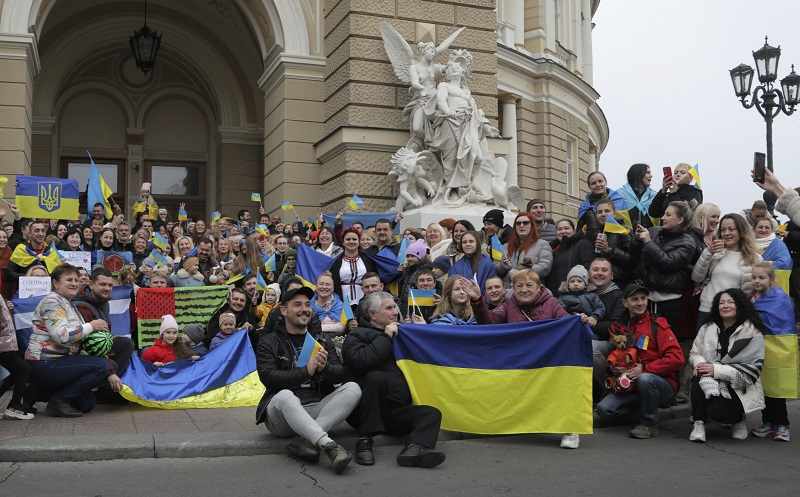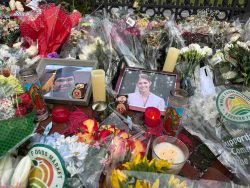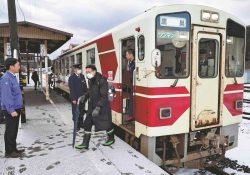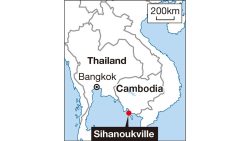
Ukrainians gather in downtown to celebrate the recapturing of Kherson city, Ukraine, Odesa, Saturday, Nov. 12, 2022.
12:34 JST, November 13, 2022
MYKOLAIV, Ukraine (AP) — Ukrainian police officers returned Saturday, along with TV and radio services, to the southern city of Kherson following the withdrawal of Russian troops, part of fast but cautious efforts to make the only regional capital captured by Russia livable after months of occupation. Yet one official still described the city as “a humanitarian catastrophe.”
People across Ukraine awoke from a night of jubilant celebrating after the Kremlin announced its troops had withdrawn to the other side of the Dnieper River from Kherson. The Ukrainian military said it was overseeing “stabilization measures” around the city to make sure it was safe.
The Russian retreat represented a significant setback for the Kremlin some six weeks after Russian President Vladimir Putin annexed the Kherson region and three other provinces in southern and eastern Ukraine in breach of international law and declared them Russian territory.
The national police chief of Ukraine, Ihor Klymenko, said Saturday on Facebook that about 200 officers were at work in the city, setting up checkpoints and documenting evidence of possible war crimes. Police teams also were working to identify and neutralize unexploded ordnance and one sapper was wounded Saturday while demining an administrative building, Klymenko said.
Ukraine’s communications watchdog said national TV and radio broadcasts had resumed and an adviser to Kherson’s mayor said humanitarian aid and supplies had begun to arrive from the neighboring Mykolaiv region.
But the adviser, Roman Holovnya, described the situation in Kherson as “a humanitarian catastrophe.” He said the remaining residents lacked water, medicine and food — and key basics like bread went unbaked because a lack of electricity.
“The occupiers and collaborators did everything possible so that those people who remained in the city suffered as much as possible over those days, weeks, months of waiting” for Ukraine’s forces to arrive, Holovnya said. “Water supplies are practically nonexistent.”
The chairman of Khersonoblenergo, the region’s prewar power provider, said electricity was being returned “to every settlement in the Kherson region immediately after the liberation.”
Despite the efforts to restore normal civilian life, Russian forces remain close by. The General Staff of Ukraine’s armed forces said Saturday the Russians were fortifying their battle lines on the river’s eastern bank after abandoning the capital. About 70% of the Kherson region still remains under Russian control.
President Volodymyr Zelenskyy said in his nightly video address Saturday that Ukrainian forces have established control of more than 60 settlements in the Kherson region and “stabilization measures are also ongoing in Kherson itself.”
“Everywhere in the liberated territory, our explosives technicians have a lot of work to do. Almost 2,000 explosive items have already been removed,” Zelenskyy said. “Before fleeing from Kherson, the occupiers destroyed all critical infrastructure — communication, water supply, heat, electricity.”
Photos on social media Saturday showed Ukrainian activists removing memorial plaques put up by the occupation authorities the Kremlin installed to run the Kherson region. A Telegram post on Yellow Ribbon, Ukrainian resistance movement, showed two people in a park taking down plaques picturing Soviet-era military figures.
Moscow’s announcement that Russian forces were withdrawing across the Dnieper River, which divides both the Kherson region and Ukraine, followed a stepped-up Ukrainian counteroffensive in the country’s south. In the last two months, Ukraine’s military claimed to have reclaimed dozens of towns and villages north of the city of Kherson, and the military said that’s where stabilization activities were taking place.
Russian state news agency Tass quoted an official in Kherson’s Kremlin-appointed administration on Saturday as saying that Henichesk, a city on the Azov Sea 200 kilometers southeast of Kherson, would now serve as the region’s “temporary capital.”
Ukrainian media derided the announcement, with the Ukrainska Pravda newspaper saying Russia “had made up a new capital” for the region.
Across much of Ukraine, moments of jubilation marked the exit of Russian forces, since a retreat from Kherson and other areas on the Dnieper’s west bank would appear to shatter Russian hopes to press an offensive west to Mykolaiv and Odesa to cut off Ukraine’s access to the Black Sea.
In Odesa, the Black Sea port, residents draped themselves in Ukraine’s blue-and-yellow flags, shared Champagne and held up flag-colored cards with the word “Kherson” on them.
But like Zelenskyy, Ukrainian Foreign Minister Dmytro Kuleba sought to temper the excitement.
“We are winning battles on the ground, but the war continues,” he said from Cambodia, where he was attending a meeting of the Association of Southeast Asian Nations.
Kuleba brought up the prospect of the Ukrainian army finding evidence of possible Russian war crimes in Kherson, just as it did after Russian pullbacks in the Kyiv and Kharkiv regions.
“Every time we liberate a piece of our territory, when we enter a city liberated from Russian army, we find torture rooms and mass graves with civilians tortured and murdered by Russian army in the course of the occupation,” Ukraine’s top diplomat said. “It’s not easy to speak with people like this. But I said that every war ends with diplomacy and Russia has to approach talks in good faith.”
U.S. assessments this week showed Russia’s war in Ukraine may already have killed or wounded tens of thousands of civilians and hundreds of thousands of soldiers.
Elsewhere, Russia continued its grinding offensive in Ukraine’s industrial east, targeting the city of Bakhmut in the Donetsk region, the Ukrainian General Staff said.
Donetsk Gov. Pavlo Kyrylenko reported Saturday that two civilians were killed and four wounded over the last day as battles heated up around Bakhmut and Avdiivka, a small city that has remained in Ukrainian hands.
Russia’s push to capture Bakhmut demonstrates the Kremlin’s desire for visible gains following weeks of setbacks. It would also pave the way to move onto other Ukrainian strongholds in the heavily contested Donetsk region.
In the Dnipropetrovsk region west of Donetsk, Russia troops again shelled communities near the Zaporizhzhia Nuclear Power Plant, the Ukrainian regional governor said.
"News Services" POPULAR ARTICLE
-

American Playwright Jeremy O. Harris Arrested in Japan on Alleged Drug Smuggling
-

Taiwan President Shows Support for Japan in China Dispute with Sushi Lunch
-

Japan’s Nikkei Stock Average as JGB Yields, Yen Rise on Rate-Hike Bets
-

Japan’s Nikkei Stock Average Licks Wounds after Selloff Sparked by BOJ Hike Bets (UPDATE 1)
-

Japanese Bond Yields Zoom, Stocks Slide as Rate Hike Looms
JN ACCESS RANKING
-

Keidanren Chairman Yoshinobu Tsutsui Visits Kashiwazaki-Kariwa Nuclear Power Plant; Inspects New Emergency Safety System
-

Imports of Rare Earths from China Facing Delays, May Be Caused by Deterioration of Japan-China Relations
-

Japan Exports Rise in October as Slump in U.S. Sales Eases
-

Govt Aims to Expand NISA Program Lineup, Abolish Age Restriction
-

Blanket Eel Trade Restrictions Rejected



























